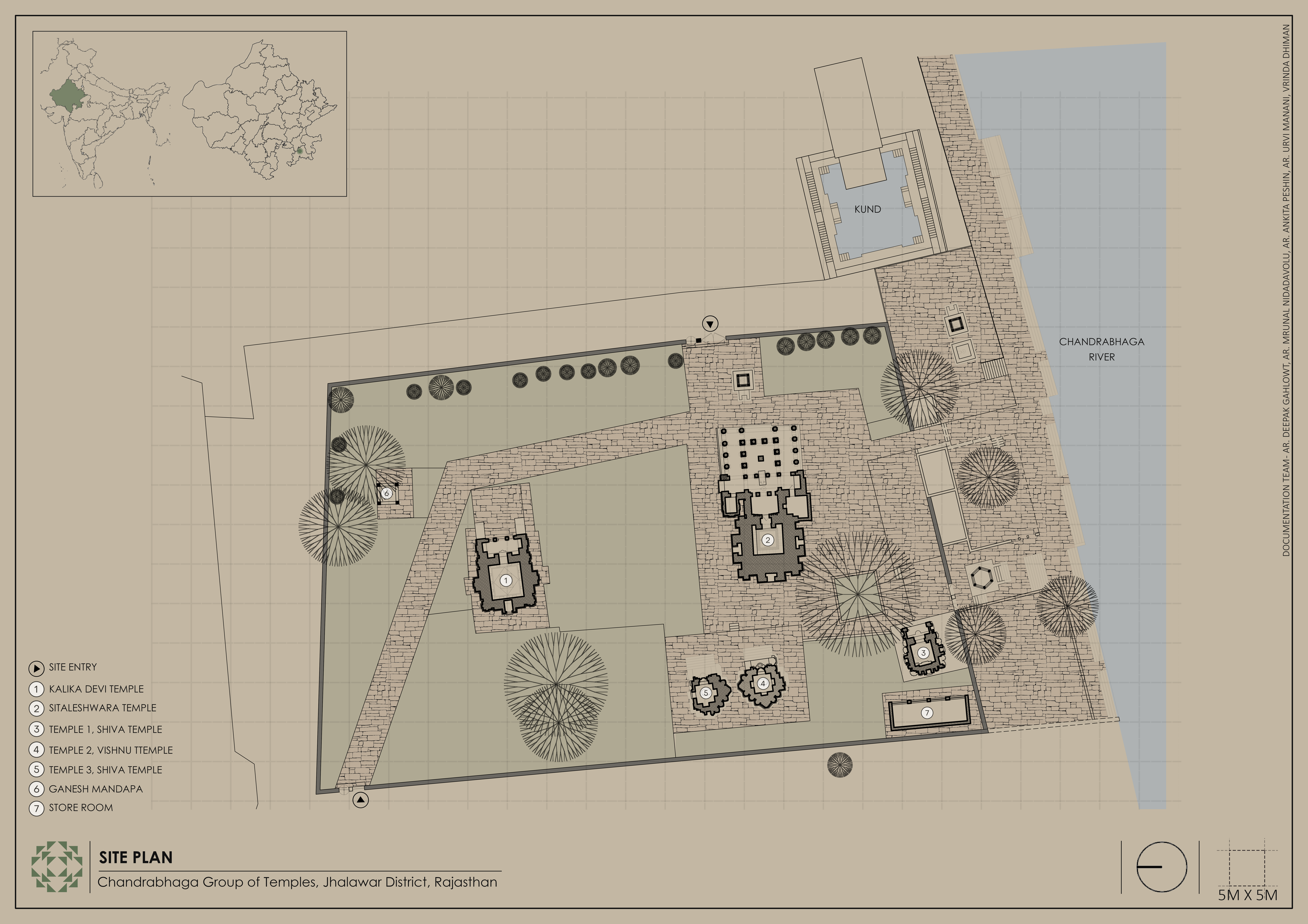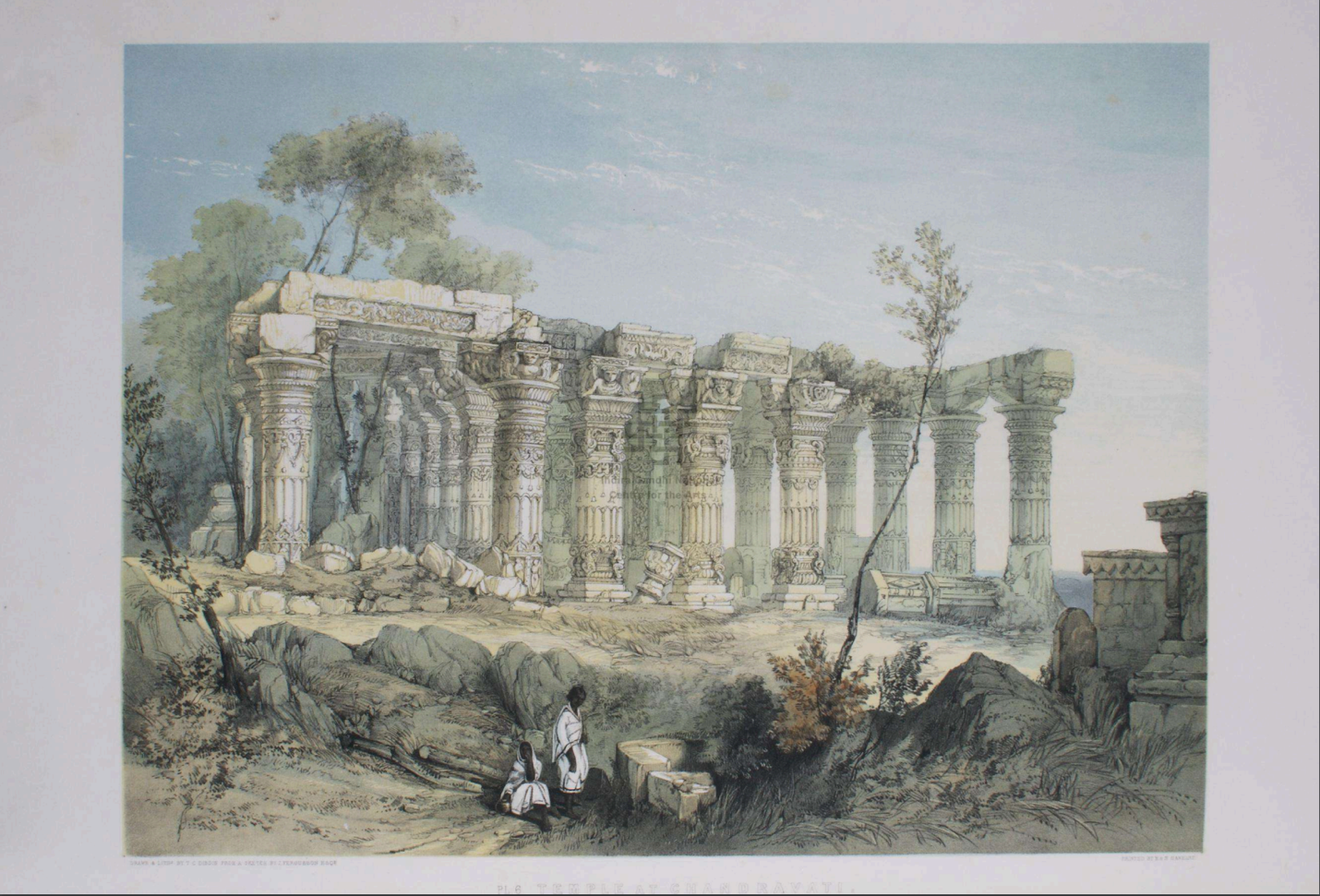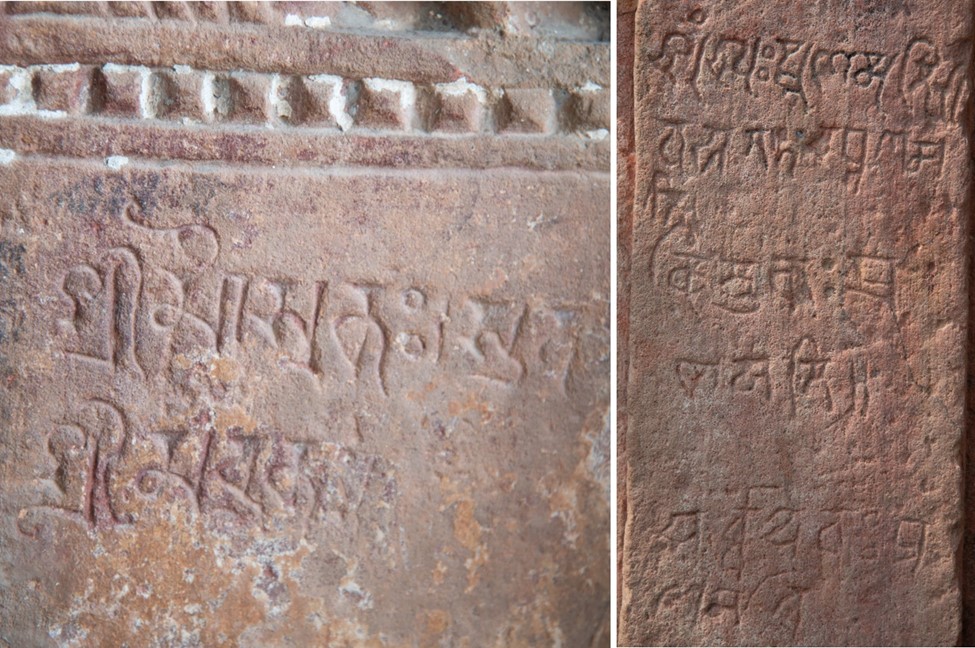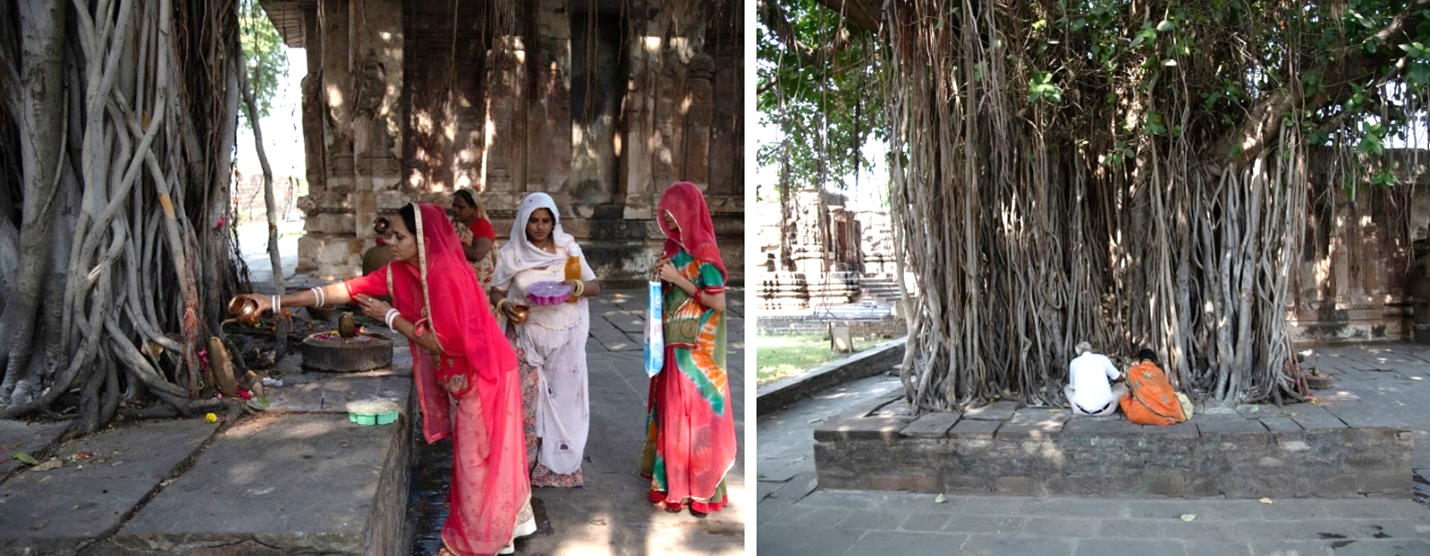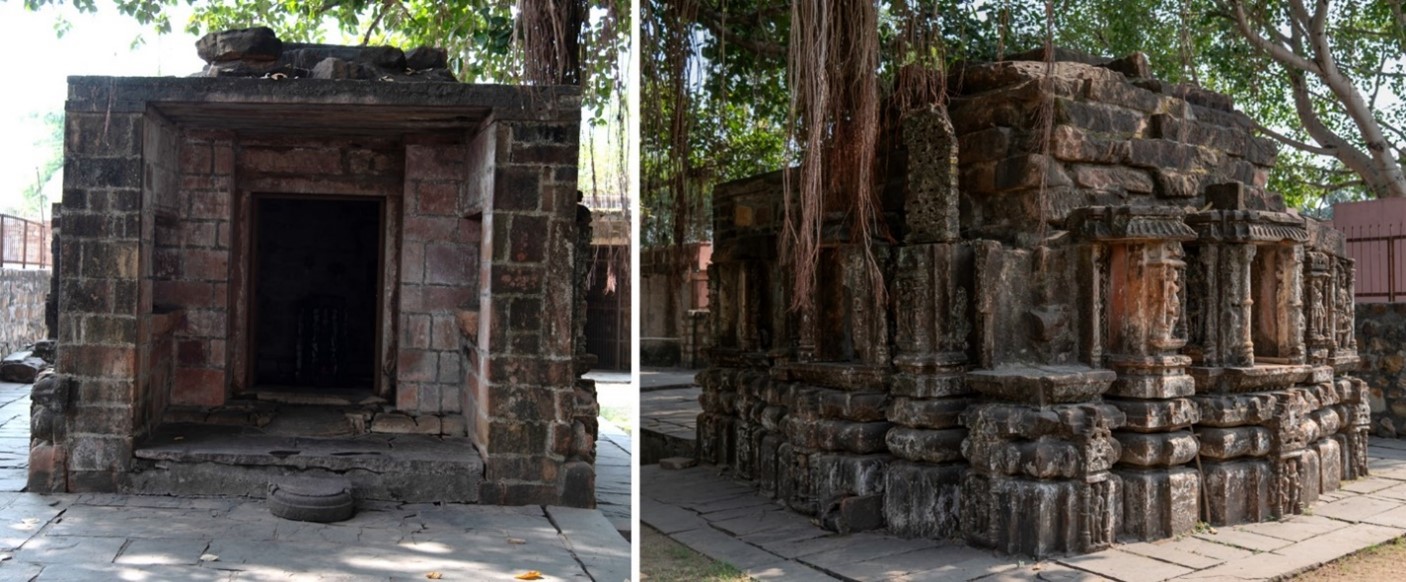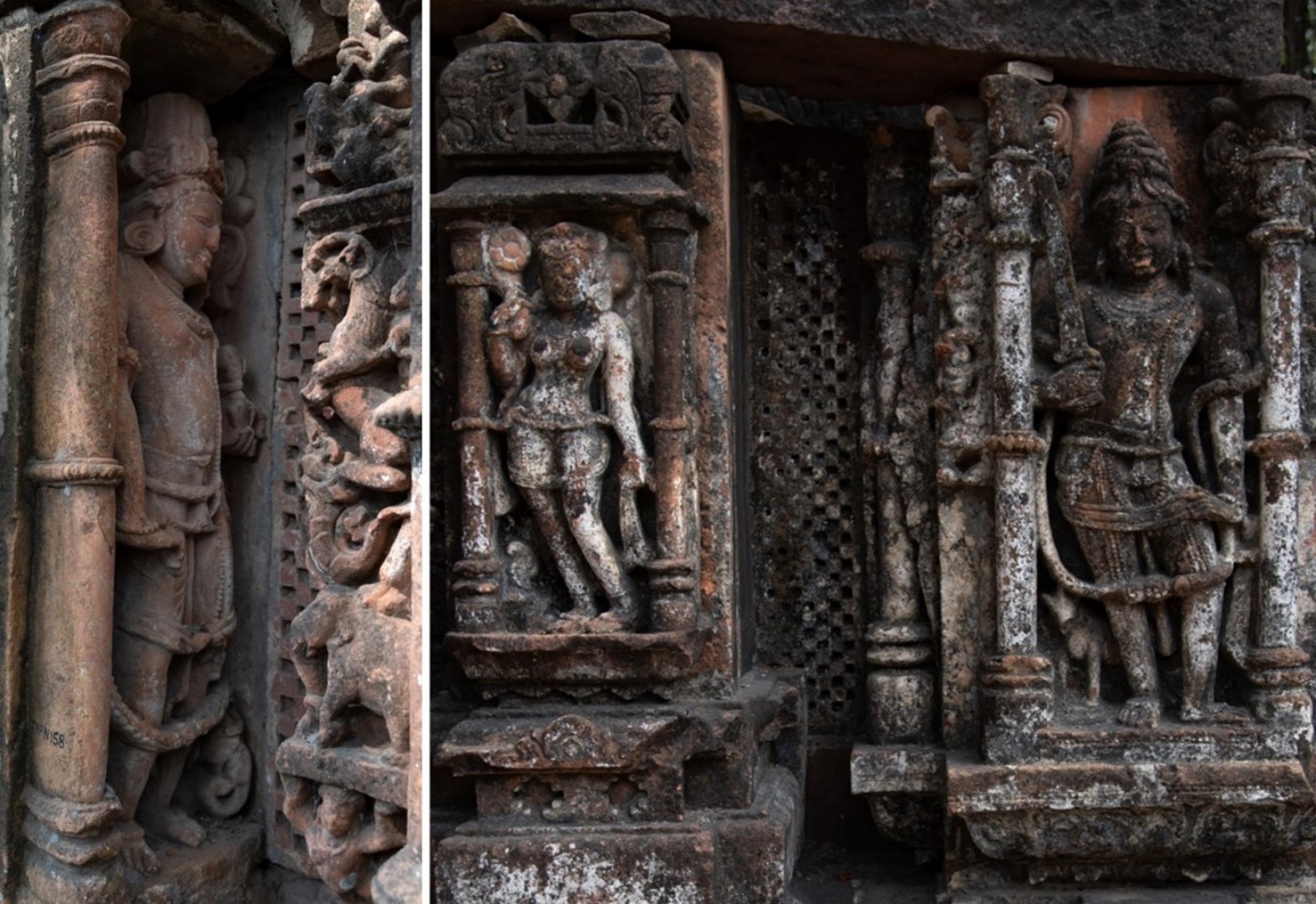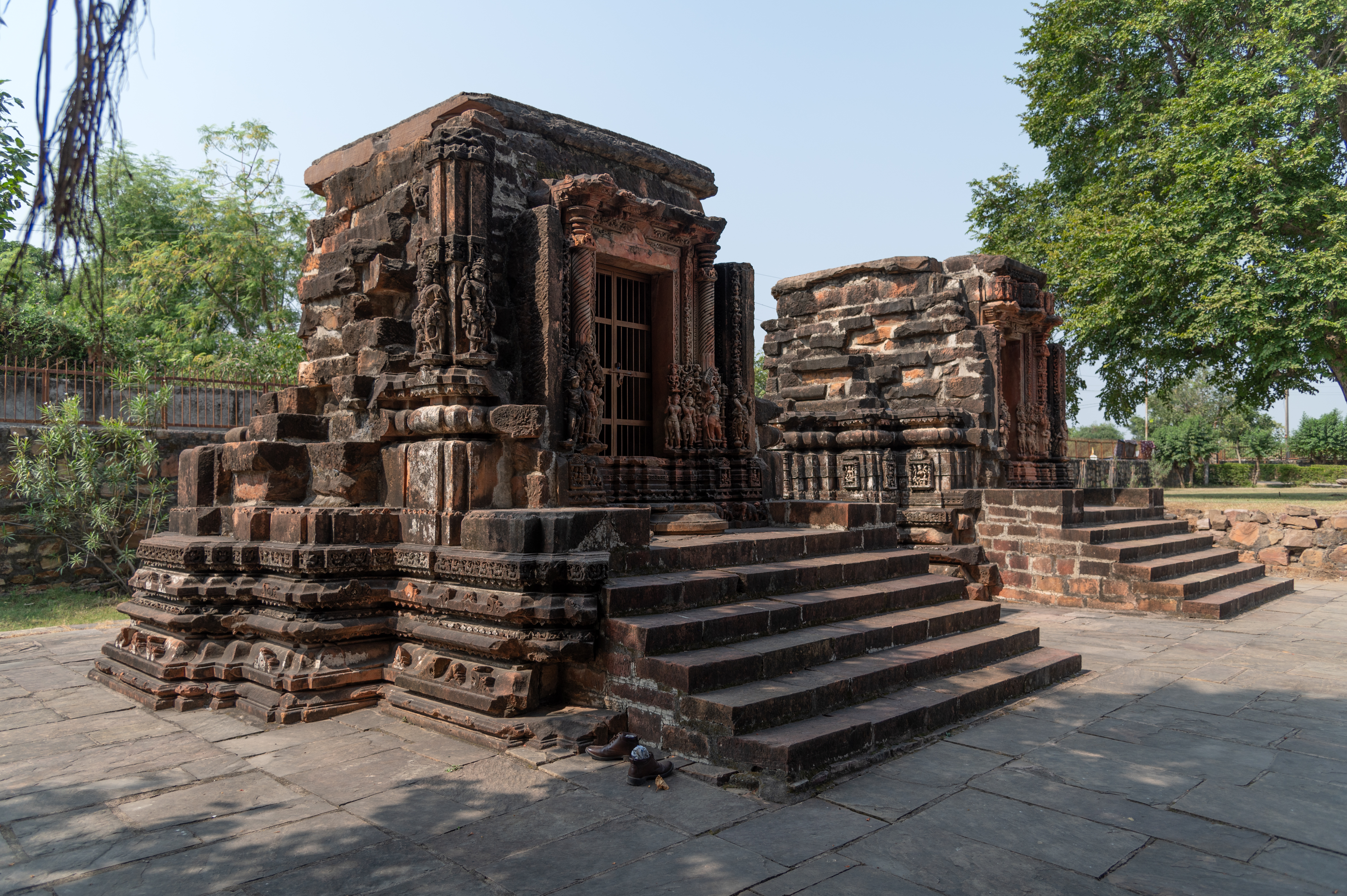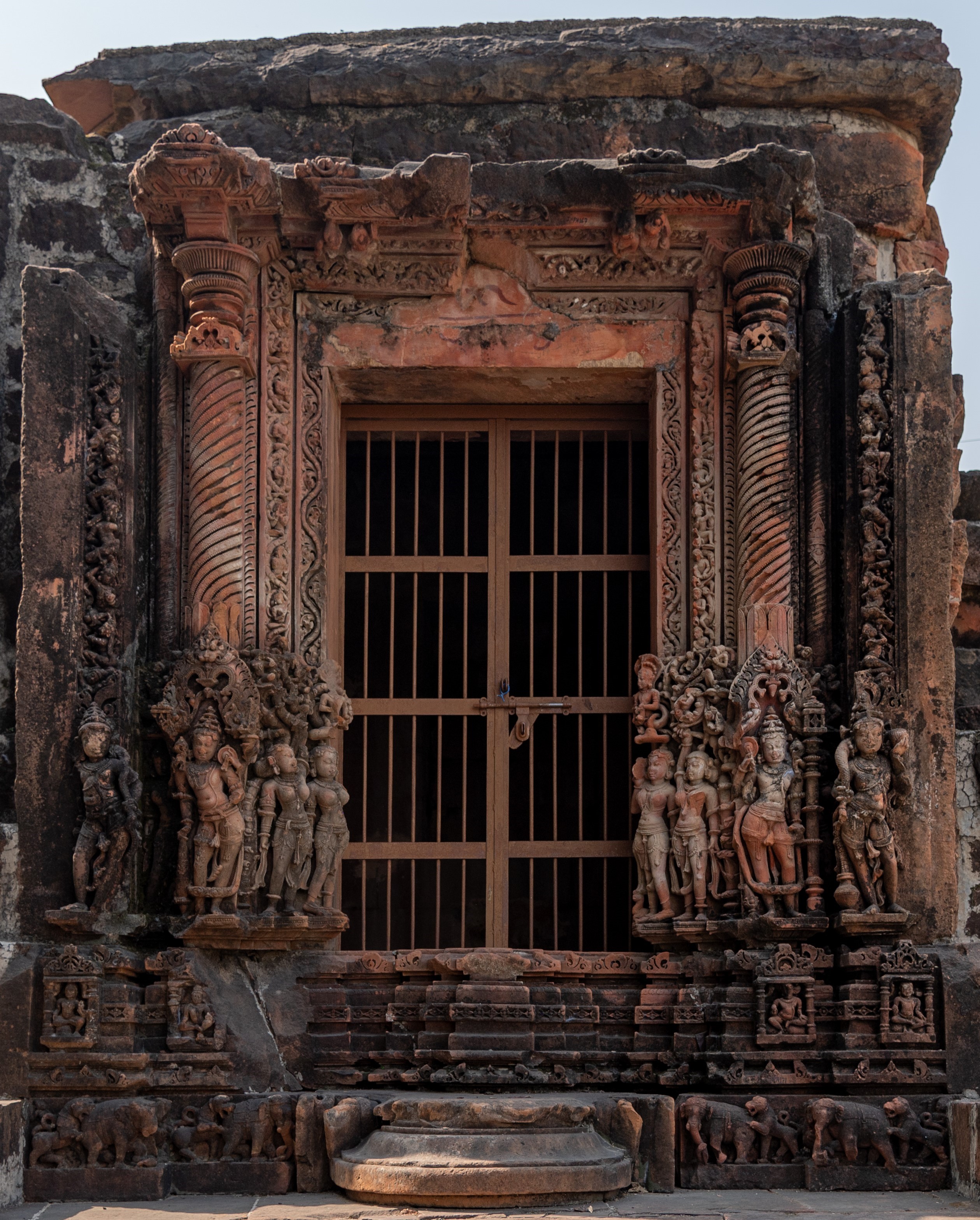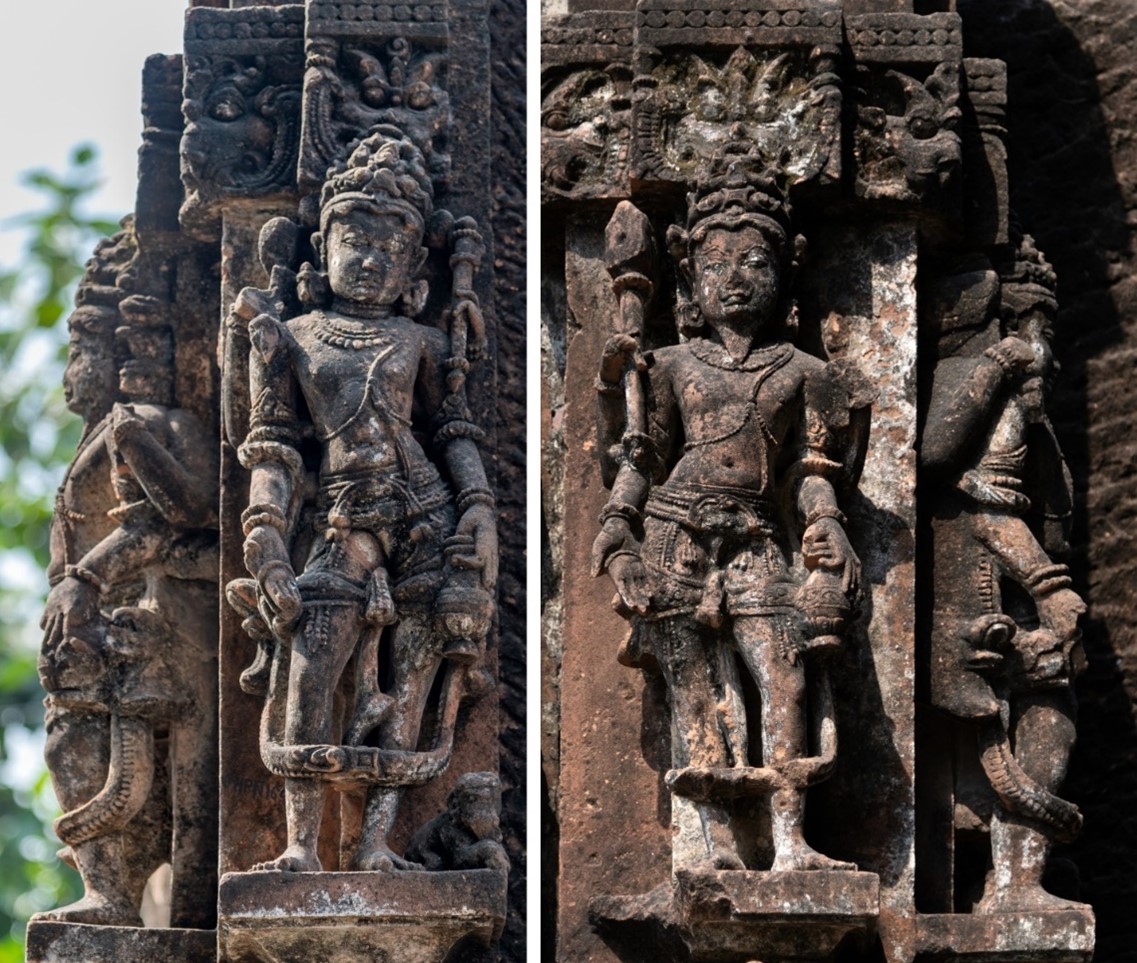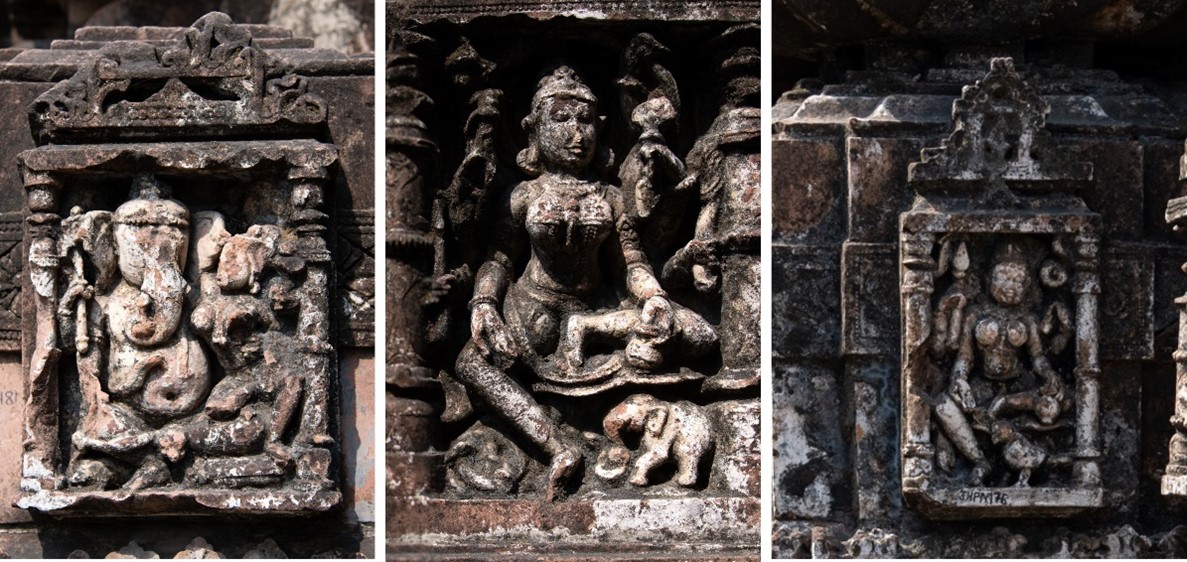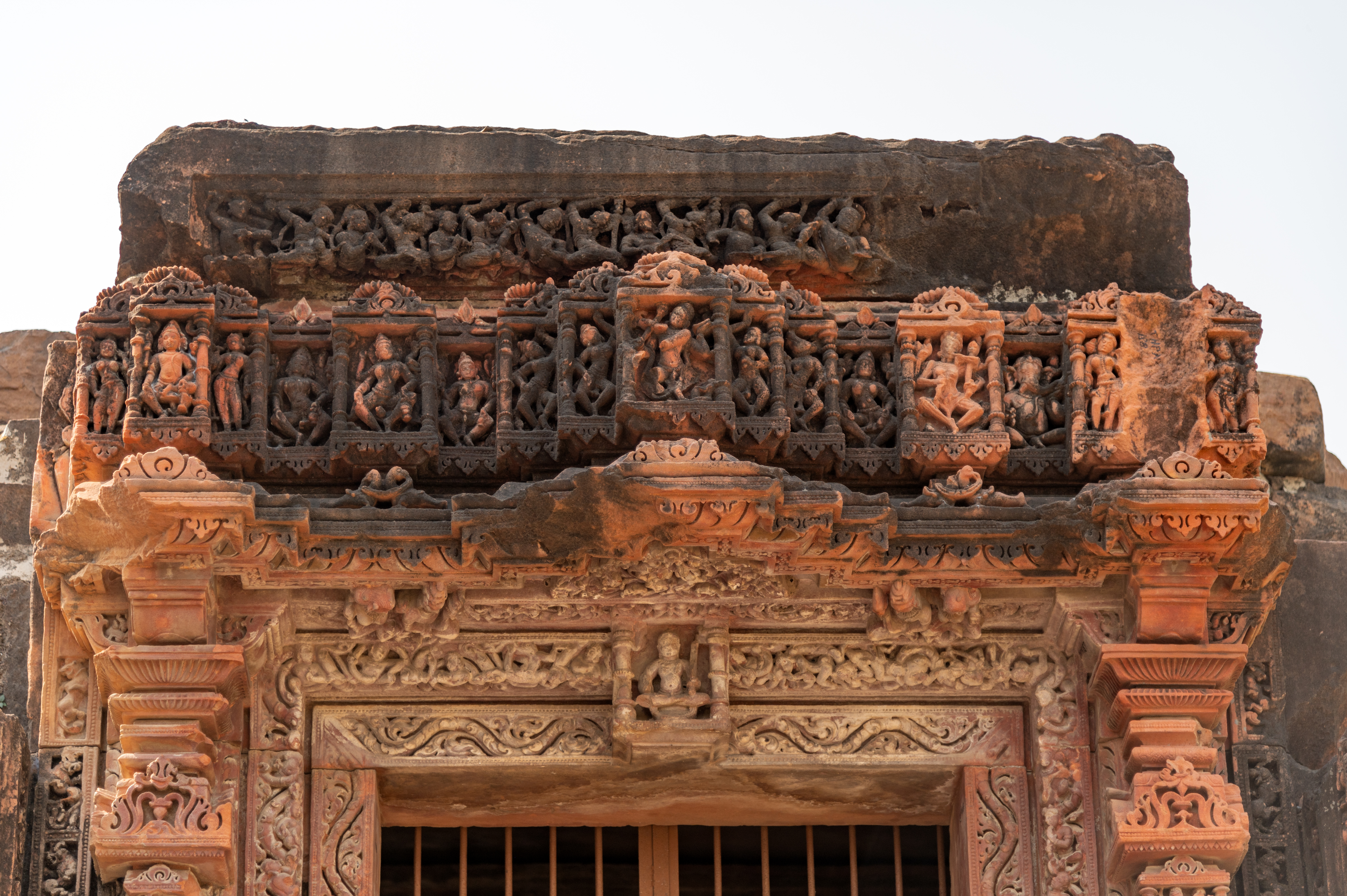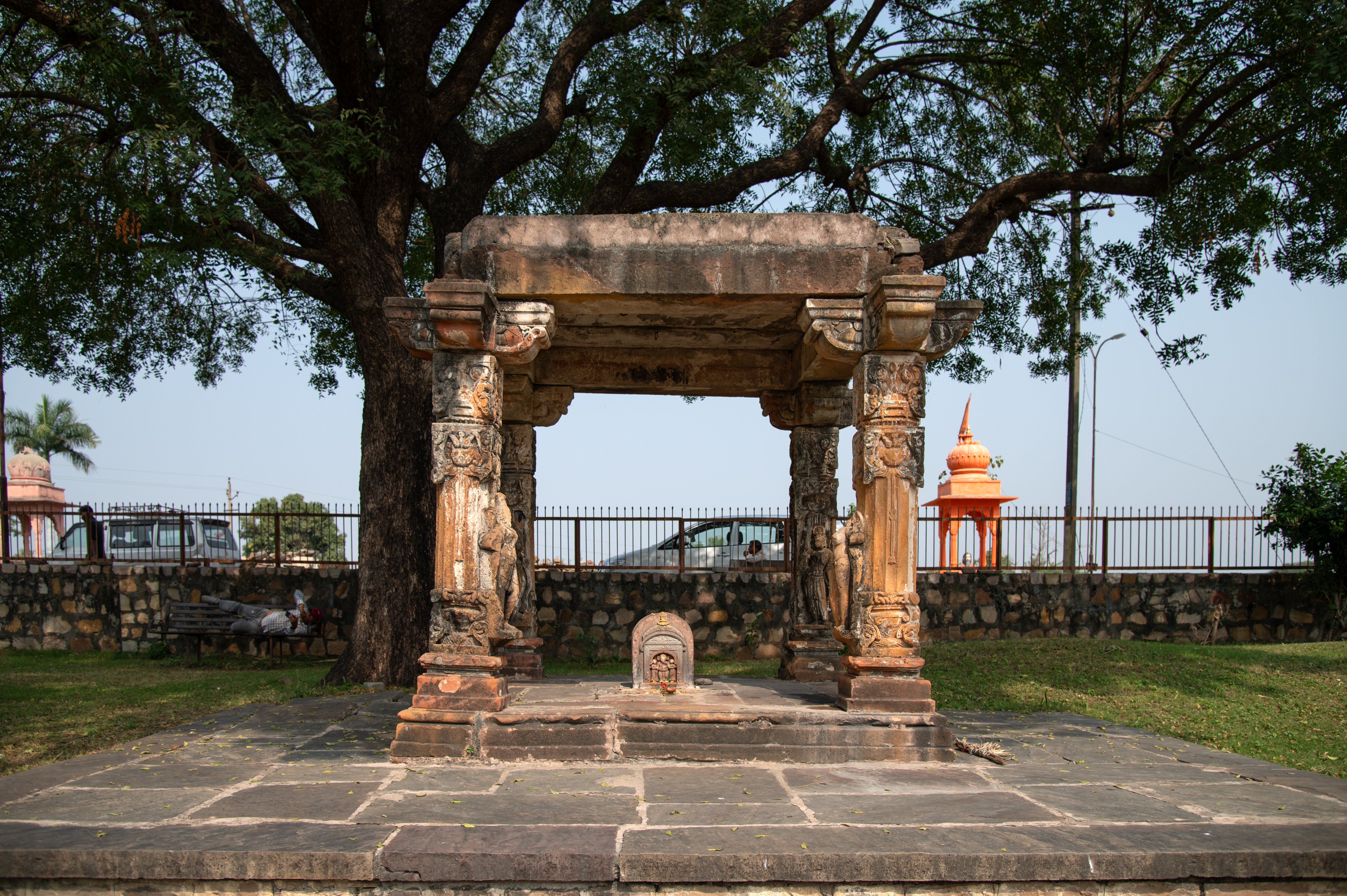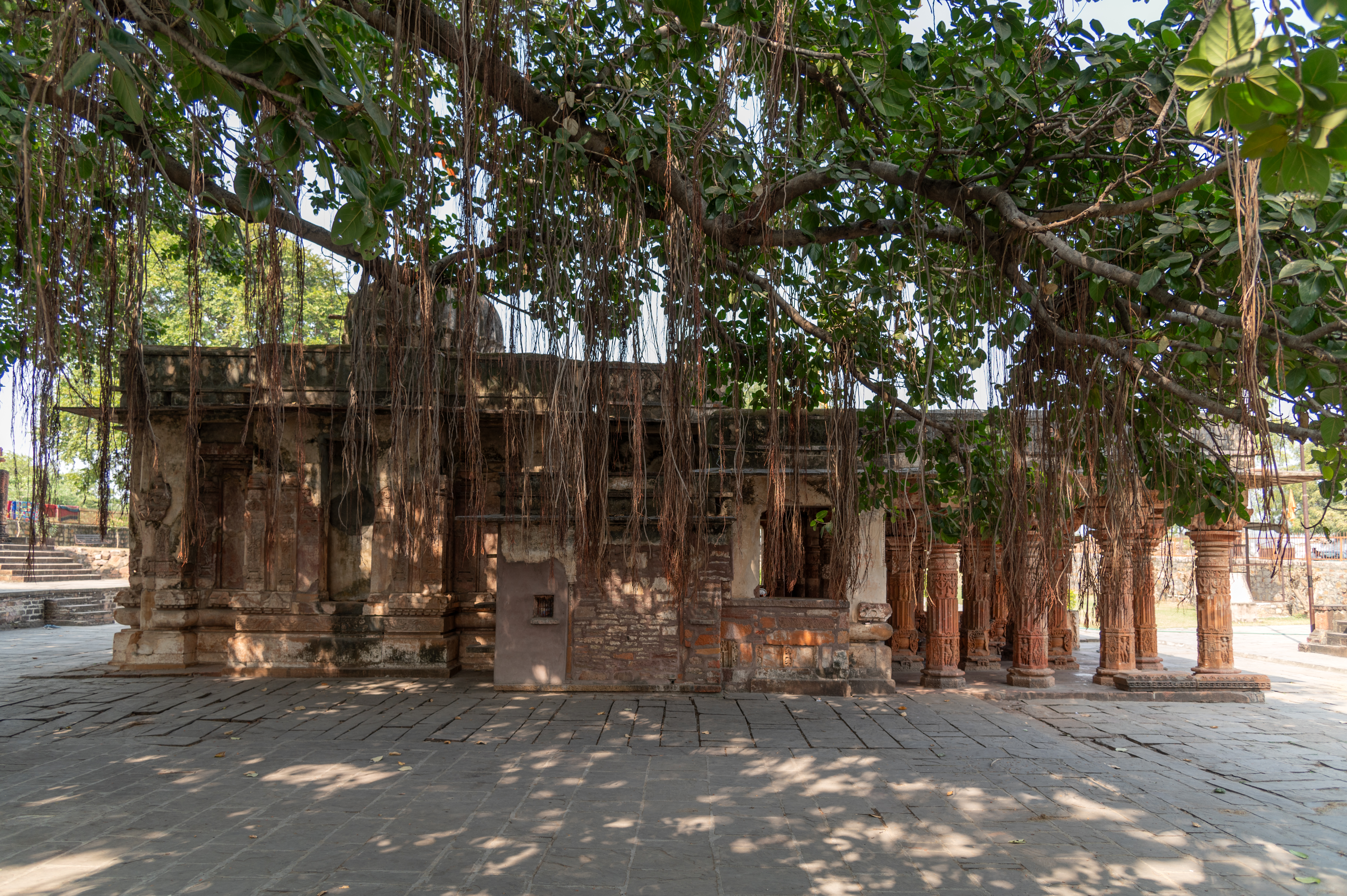Old Temples of Chandrabhaga
Chandrabhaga is the name of a river that flows in the Rajasthani district of Jhalawar, established by Jhala Jalim Singh in 1789 CE. The city was ruled by the local chief Voppak during the reign of Durggan during the 7th century CE and was famously known as Chandravati. [1] During this period, several temples were constructed. These old temples are of national importance and were added to the Inventory of Monuments and Sites of National Importance by the Jaipur Circle of the Archaeological Survey of India (ASI). [2]
The old temples of Chandrabhaga are situated in a complex. There are five intact temples and a small four-pillared mandapa (pillared hall) inside the complex that are in different states of preservation. The most famous is the Sitaleshwar temple, which is dedicated to Shiva. Two other temples are dedicated to Shiva, one is dedicated to Vishnu, and another has Mahishasuramardini in the sanctum. The mandapa has a stele of Ganesha at the centre (Image 1).
The historiography of the temples of Chandravati reveals a rich tapestry of scholarly work spanning various disciplines. Early descriptions by Col James Tod in Annals and Antiquities of Rajasthan [3] and James Ferguson's Picturesque Illustrations of Ancient Architecture in Hindostan [4] (Image 2), where they mention the Sitaleshwar Temple, laid foundational knowledge about the region's temple architecture. H. B. W. Garrick, under the supervision of the first Director General of ASI Alexander Cunningham, contributed to this body of work with concise accounts of the major intact temples. [5] Further contributions came from eminent art historians such as M. A. Dhaky, Michael W. Meister, and Krishna Deva, who examined Chandravati’s temple architecture in the Encyclopaedia of Indian Temple Architecture. [6] This initial scholarly focus on the temples continued with the detailed studies by Bhisham Pal and R.V. Somani, who have further expanded our understanding of Chandravati's architectural heritage. This collective scholarship underscores the historical and cultural significance of the temples, reflecting an evolving academic engagement over time.
The old city is believed to have been established by Raja Chandra Sena of Malwa. However, its history dates to 500–1000 BCE, as evidenced by the discovery of numerous ancient, uninscribed copper cast coins and square pieces of silver in the region. These findings indicate that the site was inhabited long before Chandra Sena's time. The current ruins, which seem to date back to the 6th or 7th century CE, suggest that Chandra Sena may have founded the city once more and named it Chandravati after himself. [7]
Also, considered a tirtha (sacred site) at the bank of the Chandrabhaga river, the old temple remains inside the complex, now protected under a boundary wall, are numbered and named according to the main deities presently found in the temple. It includes the Sitaleshwar Temple, Shiva Temple (Temple 1), Vishnu Temple (Temple 2), Shiva Temple (Temple 3), Kalika Devi Temple or Navadurga Temple (Temple 4) and the Ganesha Mandapa (Plate 1).
Cunningham gave a detailed plan of the group of Chandrabhaga temples in his account that shows the temples were known by different names previously and were dedicated to various deities. The Sitaleshwar temple is denoted as a Mahadeva temple by Cunningham, but he notes that the temple was originally dedicated to Vishnu, as evidenced by the lalatabimba (lintel) depicting Vishnu in the form of gadadhara (mace bearer). He proposed that it was subsequently converted into a shrine for Shiva. According to Cunningham, Temple 2 had an ancient statue of a four-armed god seated on a lotus, and the pedestal of this sculpture had an inscription that reads ‘Jiva’ engraved in the script of the 10th and 11th centuries. He identified the deity as Brahma. Temple 3 is recognised as a Shiva temple based on the sculptures of Shiva and Parvati. He mentioned Temple 4 as the Kalika Devi Temple, and the Ganesha Mandapa is denoted as the Varaha Temple. The archival data shows that these old temples have gone through many changes and have acquired a new identity.
The temples of Chandrabhaga have yielded a few inscriptions (Image 3). One of the inscriptions reported by Tod dates to 691 CE. [8] The inscription is from the reign of Durgagana and mentions a Shiva temple built there by Vappaka, the brother of Deva, who might have acted as a chief under Durgagana. However, when Cunningham visited the site, he was unable to find the inscription that Tod mentioned in his work. Cunnigham found other inscriptions from the Sitaleshwar Temple carved with the names of pilgrims who visited the Sitaleshwar Temple in 1096 CE. [9]
In the complex, there are a few chhattris (arched roof structures) and on the right side of the Sitaleshwar Temple, there is a ghat (riverbank). At the bank of the ghat, there are the remnants of a few more temples, evidenced by old sculptures and architectural remains. There is an old banyan tree (Ficus bengalensis) in the Chandrabhaga temple complex, between the Sitaleshwar Temple and the Shiva Temple (Temple 1), under which a few Shiva lingas (aniconic representations of Shiva) are placed. These lingas and the tree are worshipped by the devotees after taking a bath in the river (Image 4). The presence of the banyan tree at the Chandrabhaga Tirtha is considered auspicious, as the banyan tree, known locally as bargad/bargat, is considered the tree of life. It is popularly believed that the banyan trees symbolize the trimurti: Vishnu, Shiva, and Brahma. In most Hindu cultures, this tree represents life and fertility, and because of this belief, married women worship the banyan trees for the long life of their husbands. As banyan trees are considered wish-fulfilling trees and are associated with fertility, married couples worship the banyan trees to fulfil their wish to have children (Image 4). [10]
Chandrabhaga functions as both a temple and a pilgrimage site, where visitors worship, cleanse themselves in the river, and conduct rituals beneath the sacred tree, including lighting lamps. In the month of Kartik (October-November), numerous devotees flock to this place to bathe in the river and illuminate dipaks (lamps), as it is regarded as an auspicious custom during Kartik maas (month). Kartik is the fourth month of Chaturmaas in the Hindu calendar, a holy period of four months during which Vishnu enters his yogic sleep. Kartik is revered as Lord Vishnu's favourite month, and Hindu tradition emphasizes the performance of religious and spiritual deeds during this time.
Shiva Temple (Temple 1):
Standing to the left of the Sitaleshwar Temple behind the banyan tree, the temple has deteriorated over time and is in a bad state of preservation. It is dedicated to Shiva and has an antarala (vestibule) and a garbhagriha (sanctum sanctorum) (Image 5). The shikhara (superstructure) of the temple is severely damaged. The antarala of the temple is entirely plain and unadorned. There are two niches on the lateral sides. The antarala leads to the garbhagriha. The doorframe of the garbhagriha is plain, and there is no figure on the lalatabimba. The garbhagriha is a square dark chamber with a Shiva linga with four sides showing four standing deities.
The Shiva Temple has basic mouldings comprised of the vedibandha (basal mouldings). It includes khura (hoof-shaped moulding), kumbha (high basal moulding with pot-shaped or curved shoulder), kalasha (pitcher-shaped or tourus moulding), and kapotapalika (cyma recta) (Image 5). The kumbha has niches installed with figures of women, couples and dwarves. Above the moulding, there are central projected niches flanked by slightly narrow projected niches on the jangha (wall) (Image 5). The central niches are empty, and the adjacent niches depict apsaras or surasundaris (celestial damsels). The corners of the jangha are also projected and depict dikapalas (deities of the cardinal directions) in the niches. The surasundaris are shown standing flexed, holding a flower stalk in one hand and the edge of the scarf in the other (Image 6). Their voluptuous bodies, posture, floating scarf, and curving flower stalks create a sense of rhythm that makes these sculptures beautiful.
The dikapalas are carved on the corners of the walls. At present, only a few dikapalas remain intact, and several are missing from their niches. Indra, the deity of the east, is carved on the east face of the southern wall (Image 6). He is depicted with two arms, with a vajra in his left hand and his right hand on his thigh. His vahana (mount) Airavat, an elephant, is also shown on his left at the bottom. Another dikapala is depicted on the western wall of the garbhagriha. He is also a two-armed diety, shown holding a khadga (sword) in his right hand with his left hand on his thigh. He is crowned and adorned with jewels, and his vahana is depicted at the bottom (Image 6).
Just behind the Sitaleshwar Temple are two temples on a platform (Image 7), Temples 2 and 3. Both temples presently have only a garbhagriha that can be reached via steps. The doorframes of both temples are ornately carved with multiple shakhas (branches) and depict river goddesses and dvarapalas (door guardians) at the bottom, along with a beautiful figure of Kubera.
Vishnu Temple (Temple 2):
The temple currently has no deity in the garbhagriha, but the sculptural representations on the doorframe show Vaishnava dvarapalas, which suggests that the temple was dedicated to Vishnu. It has ornately carved base moulding that includes a pitha (pedestal), kapotapalika, karnika (knife-edged arris moulding), gaggarika (decorative motif comprising of an arrow between two spirals), and antarapatta (recess between mouldings). Above this patta (band), a grassapatta (band of kirtimukhas or face of glory motif) can be seen that supports the kumbha and kalasha mouldings. Its external walls have lost their adornments (Image 7). However, the presence of a few sculptures suggests that the walls were entirely carved with beautiful statues of deities.
The most beautiful element of this temple is its intricately carved doorframe, which portrays the aesthetic taste of its patron and the skills of the sculptors of that period. The doorframe (Image 8) has panchashakha (five branches). At the bottom, there is a chandrashila (lowest step shaped like a half moon) with shankhas (conch) on both sides. Flanking the chandrashila is a band that shows vyalas (composite mythical animals) pouncing upon elephants. The udumbar (threshold) is comprised of a moulding that shows a running band of ratnas (diamond motifs) and depicts deities in miniature niches.
The doorframe of the garbhagriha portrays river goddesses, dvarapalas, and Kubera (god of wealth and a cardinal deity). The first shakha from the door depicts Ganga on the right and Yamuna on the left. Ganga and Yamuna are shown with their vahanas makara (crocodile) and kachhapa (tortoise), respectively. At the bottom of the next set of shakhas, female chauri (fly whisk) bearers are shown with bejewelled, voluptuous bodies. On the sides of both chauri bearers, there are lata (creepers) moving upward, creating curvaceous loops above their head. In these loops, musicians and deities are shown seated.
The third set of shakhas of the door have the figures of Vaishnava dvarapalas (Image 8). These four-armed dvarapalas are shown holding a gada (mace), a shankha (conch), a chakra (discus), and one of their hands is held in abhaya hasta (fear-not hand gesture). The dvarapalas are wearing karandmukutas (tiered crowns), long garlands, and jewellery. The next group of shakhas is carved in recesses where female attendants are carved. The final shakha has a depiction of a standing Kubera with two arms, one of which holds a money bag with a pot of nidhi (wealth) placed at the bottom.
The upper portions of the shakhas are intricately carved with a variety of designs (Image 8). The first shakha shows undulating foliage moving vertically. The second shakha depicts a creeper moving upward, forming loops in which figures are depicted. The third and fourth shakhas are stambha (pillar) shakhas decorated with beads and rosette bands. The last shakha depicts warriors one above the other, with their respective weapons.
Sculptures on the external wall depict the dikapalas. Indra (Plate 9) is depicted on one of the projected corners of the garbhagriha on the east. There is a depiction of a young, charming Indra with four arms wearing a mukuta (crown) and carrying a vajra (thunderbolt) and staff in his upper hands. With his lower right hand, he is making a varada hasta (boon-giving gesture) and holds akshamala (rosary) in it. In his lower left hand, he holds a kamandalu (water pot). His vahana, Airavat, is shown sitting at the bottom.
Agni (Image 9) is depicted on the southern wall at the corner, next to Indra. He is shown as a young deity with a moustache and beard, having four arms in which he holds a shruka (a spoon used for performing yajna), a kamandalu, and varadaksha (boon-giving gesture holding a rosary). Next to the figure of Agni, a vyala (composite mythical creature) is shown being attacked by a royal rider.
Shiva Temple (Temple 3):
The temple next to the Vishnu Temple is similar in plan and follows a similar style. This temple is dedicated to Shiva and is covered with the figures of deities associated with Shaivism, such as Matrikas. The temple has a square, plain garbhagriha in which a Shiva linga is placed at the centre. It has profound, well-carved mouldings and jangha.
The mouldings of the base have all the mouldings present in Vishnu Temple. The kumbha has miniature niches installed with the figures of Matrikas (mother goddesses) and other deities, such as Ganesha with his consort (Image 10). There is a beautiful sculpture of Kaumari (Image 10) sitting on her vahana Mayura (peacock). This depiction has four arms. She holds a shakti (weapon) and a flower in her upper hand and a kamandalu in her lower left hand. Her lower left hand depicts the boon-giving gesture and holds a rosary.
The kumbha has a depiction of Indrani (Image 10) with six arms that hold a broken weapon and a vajra (thunderbolt) in her upper hands, unidentified attributes in her middle hands, and kamandalu and varadaksha in her lower hands. At the bottom of her pedestal, an elephant is depicted. Ganesha is also represented in the kumbha, where he is shown seated, holding ankusha (bull hook) and looking towards his consort, who is sitting in his lap embracing him.
The jangha was once adorned with many sculptures that have now fallen, and the internal structure can be seen now. The shikhara of the temple has also collapsed. The most beautiful part of this temple is the doorframe of the garbhagriha, which is carved like the doorframe of Vishnu Temple. However, it is in a better state of preservation as the lalatabimba and the uttaranga both are intact. On the lalatabimba, there is a Lakulisha (Image 11) in a miniature niche seated in padmasana (sitting posture). He holds a phala (fruit) and a danda (staff) in his hands. On both sides, gandharva (celestial musicians) couples are depicted holding garlands.
The uttaranga (Image 11) of this temple depicts Matrikas and Veerabhadra with Ganesha and Brahma. On the left side of the panel is a carving of a seated Ganesha with two arms. Next to him, Chamunda is shown dancing. She is depicted with four hands holding a damru (hourglass-shaped drum), khatvanga (staff with a human skull), and a dagger, with the last hand touching her lips with her little finger. She has a skeletal body and a sunken belly. Her lower body is covered with a loin cloth, and a snake is tied around her waist. Next to her is another four-armed depiction of a Matrika, and then Varahi is depicted with the face of the boar in profile and a female body.
At the centre of the panel, Veerabhadra is depicted dancing to the beats of the drum, which is being played by a drummer, shown at the bottom. The sculpture had four arms, but two of his front arms and legs are presently broken. In his upper two arms, he is holding a khatvanga and a kapala (bowl made from a human skull). His broken front left hand suggests that he is making danda hasta. He is flanked by female dancers on both sides.
Next to the central dancing figure of Veerabhadra are three more Matrikas. One of them is Maheshwari, depicted with four arms. She is wearing a crown and has a halo behind her head. She holds a sarpa (snake) in her upper left hand and a kamandalu in her lower left hand. Her lower right hand is in varada hasta and carries a rosary. Next to Maheshwari is a sculpture of Brahmani, depicted with three faces and four arms. She has her respective attributes in her upper hands, and in her lower hand, she carries a kamandalu and akshamala like the other Matrikas.
The panel ends with a three-faced male deity shown in varada hasta, holding kamandalu and carrying his respective attributes in his four arms. Two female figures flank him. Above the uttaranga, a long panel is carved depicting a large number of people engaged in fighting with their weapons. The sculptures are shown frontally, and some are shown from behind. They are carrying swords, sickle, dagger, and mace.
Kalika Devi Temple (Temple 4):
There is a flat-roofed structure (Image 12) at the northern entrance of the Chandrabhaga temple complex. The structure is popularly known as the Navadurga shrine, but Cunningham described the temple as Kalika Devi Temple [11]. The temple is presently used as storage by ASI and has several loose sculptures inside its garbhagriha.
Comprised of a garbhagriha and antarala, the exterior walls of the garbhagriha of the temple are plain and devoid of decoration and sculptures (Image 12). The antarala leads to the garbhagriha via an adorned door. The doorframe was multi-shakha, but the current doorframe is the result of restoration work, evidenced by the two different decorative and sculptural schemes. The original door comprises shakhas and lintel on the right that reflect the Vaishnava theme, but the left part of the door reflects a Shaiva theme, suggesting that this part was previously part of a Shiva temple and placed here later. The bottom of the original doorframe on the right shows a Vaishnava dvarapala flanked by two female attendants. He holds a shankha, a chakra and a gada. The shakhas are decorated with floral designs, and one of the shakhas depicts human figures in pairs engaged in different activities. The lintel of the doorframe shows seated Vishnu at the centre, flanked by Navagrahas (nine planets). The garbhagriha is a large square chamber.
Ganesha Mandapa:
There is a small mandapa (pillared pavilion) near the Kalika Devi Temple that houses Ganesha. The mandapa is a four-pillared open structure with a flat roof (Image 13). It is standing on a stone platform and has a low plinth base. The pillars have square bases with purnaghata kalasha (vase of plenty). The middle part of the shaft is faceted and carved with standing female figures. At the top portion, each face of the shaft has grassamukha, topped by a floral motif abacus. Above the abacus, there are brackets in place to support the flat roof.
This open mandapa has a stele at the centre carved with the figure of Ganesha with his consorts (Image 13). This four-armed depiction of Ganesha is shown standing inside a pavilion. Ganesha holds his consorts, portrayed on either side of him, with his backhands. In his front left hand, he holds an akshamala while his front right hand points towards the ground. One of his consorts is shown holding modak (a type of sweetmeat), and the other is holding his hand.
Sitaleshwar Temple:
The Sitaleshwar Temple (Image 14) is the central attraction of the Chandrabhaga group of temples. In active worship, the temple has a pillared mandapa, an antarala, and a garbhagriha. The exterior walls have vedibandha and a beautifully adorned jangha. The shikhara of this temple is lost, and presently, only a flat roof can be seen over the mandapa and the antarala. Fergusson also mentioned the dilapidated state of the temple. [12] The garbhagriha presently has a small dome at the centre, which was a later addition to the structure. The different carvings and styles of the pillars of the antarala and mandapa of the structure reflect the building activities in the temple in different periods. The pillars of the mandapa are carved with figures of surasundaris, deities, and Shaiva ascetics. The mandapa leads to the antarala, where there is a figure of Nandi. The garbhagriha has a decorated doorframe and a Shiva linga inside it.
Previous studies of the old temples of Chandravati highlight the history, art, and architecture of these temples. The study of Chandravati's temples reveals a history of transformation. The ASI reports mention different names and deities for these temples than their current names and housed deities. It appears that Chandrabhaga has been a significant temple site and tirtha, and the temples acquired new affiliations and practices by adapting the regional religious and cultural relevance over time.
Footnotes:
[2] Joshi, Deva, and Meena. Inventory of Monuments and Sites of National Importance Volume II, Part I Jaipur Circle, 155.
[3] Tod, Annals and Antiquities of Rajasthan.
[4] Ferguson, Picturesque Illustrations of Ancient Architecture in Hindostan.
[5] Garrick, Archaeological Survey of India Report of a Tour in the Panjab and Rajputana in 1883-84, Volume XXIII.
[6] Meister, Dhaky and Deva. Encyclopaedia of Temple Architecture North India Foundation of North Indian Style.
[7] Cunningham, Archaeological Survey of India Report Vol II, 264.
[8] Ibid. 265.
[9] Ibid.
[10] Wani, Sahoo and Gupta, “Sacred Trees of India: Traditional Approach towards Plant Conservation,” 2603.
[11] Mankodi, “Śītalā, and Śiva as “Śītaleśvara”, 165-190.
[12] Fergusson, 35.
Bibliography:
Cunningham, Alexander. Archaeological Survey of India Report Vol II, Delhi: Rahul Publishing House, 1994.
Garrick, H. B. W. Archaeological Survey of India Report of a Tour in the Panjab and Rajputana in 1883-84, Volume XXIII. Delhi: Rahul Publishing House, 1994.
Ferguson, James. Picturesque Illustrations of Ancient Architecture in Hindostan. London: 1848. https://archive.org/details/dli.ministry.26641/page/15/mode/2up?q=Chandravati
Joshi, J. P., Krishna Deva, and B. R. Meena. Inventory of Monuments and Sites of National Importance Volume II, Part I Jaipur Circle. New Delhi: Archaeological Survey of India, 2006. https://ignca.gov.in/Asi_data/88329.pdf
Meister, Michael, M. A. Dhaky, and Krishna Deva. Encyclopaedia of Temple Architecture North India Foundation of North Indian Style. Delhi: American Institute of Indian Studies, 1988. https://archive.org/details/encyclopaedia-of-indian-temple-architecture-ii-pt.1-text/mode/2up
Dhaky, M. A. Encyclopaedia of Temple Architecture North India Beginning of Medieval Idiom. Delhi: American Institute of Indian Studies, 1988.
Mankodi, K. L. “Śītalā, and Śiva as “Śītaleśvara” in Berlin Indological Studies 24 (2019): 165–190.
Mishra, Ratanlal. Inscriptions of Rajasthan. Vol IV. New Delhi: Himanshu publication, 2006.
Pal, Bhisham. Temples of Rajasthan, Alwar: Prakash Publishers, 1969.
Tod, James. Annals and Antiquities of Rajasthan. London: Oxford University Press. 1920.
Wani, Afaq Majid, Gyanaranjan Sahoo, and Shubham Gupta, “Sacred Trees of India: Traditional Approach towards Plant Conservation” in International Journal of Current Microbiology and Applied Sciences, 2603. https://www.ijcmas.com/9-1-2020/Afaq%20Majid%20Wani,%20et%20al.pdf
